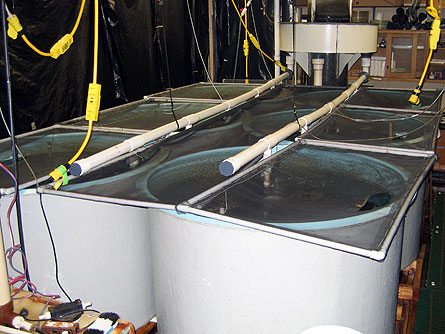Fish shrinkage reversible, but better hurry
Study suggests fisheries managers need to consider evolutionary changes created by the selective harvesting of larger fish
People can reverse evolution when it comes to the effects of fishing on sea creatures, researchers say. Just don’t hold your breath.


The common practice of catching only the bigger fish in a population becomes an evolutionary pressure for later generations to stay small and grow slow, says fisheries scientist David Conover of Stony Brook University in New York.
He and his colleagues now report a lab experiment on silverside fish that stops the shrinkage trend and nudges the fish population back toward larger sizes. Changing the direction of the selective pressure by eliminating the “take the big ones” rule brought back a noticeable size increase within five generations, Conover and his colleagues say in a study released March 3 in Proceedings of the Royal Society B.
“It’s the first experimental demonstration of reversing fisheries-induced evolution,” Conover says.
Fisheries biologist Mikko Heino of the University of Bergen, Norway, calls the work “a very interesting and important paper.” It’s a unique study, he says, with results that support predictions that any recovery will be slower than the evolutionary effects of fishing.
Theorists have debated whether shrinking fish would recover even if fishing stops, Conover says. One argument states that relentless fishing could have such a strong effect that afterward the usual forces of natural selection might be too mild to push back hard enough to restore size briskly.
To address the question with experiments instead of models, Conover and his colleagues caught hundreds of silversides (Menidia menidia) in Great South Bay, N.Y. A modest commercial fishery along the East Coast takes them as bait.
The researchers divided them into six populations. For two groups, Conover routinely caught the large individuals, taking all but the smallest 10 percent. He targeted small fish in two of the other groups, and removed fish randomly from the remaining groups. After five years, about five generations, the catch-big populations had a smaller average size than the comparison groups.
For the next five years, Conover and his colleagues kept the populations but changed the rules. Instead of fishing based on size, he removed fish randomly from all groups. At the end of the five years, the shrinking trend had reversed and adults in the catch-big populations had regained half their original length, on average.
For the shrinkage, “the good news is, it’s reversible,” Conover says. “The bad news is, it’s slow.” The average size didn’t increase as fast as it shrank. If the silversides maintain their current pace, Conover calculates, they will need 12 years to return to their former size.
Just how Conover’s research would apply to ocean fish in the wild is “an open question,” Heino says.
Conover notes one difference himself. Seven years isn’t unusual for the life span of a commercial fish species. Twelve generations, even assuming another species matched the silversides’ speed for recovery, could take 84 years to recover size. The best path, he says, is to avoid the evolutionary shrinkage to begin with or stop it as soon as possible.
“That’s the biggest implication — you’d better hurry,” says fisheries management specialist Ellen K. Pikitch, who directs the Institute for Ocean Conservation Science at Stony Brook, which helped start the 10-year research project.
Fisheries managers need to pay attention to evolutionary forces, the study concludes. For example, rules could change from “catch the biggest” to a slot limit, which allows fish to be caught only at intermediate sizes. Such an arrangement could put evolutionary pressure on fish to grow fast, spending as little time as possible in the perilous size range.






